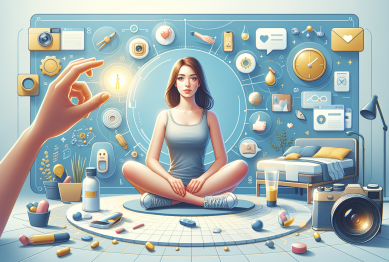If creativity feels like a skill reserved for artists and innovators, it’s time to rethink that. Achieving a more creative mindset isn’t about becoming someone new—it’s about making space for curiosity, experimentation, and the freedom to explore ideas without pressure. The good news? You don’t need a long weekend or a month-long retreat. You can shift your perspective and unlock your creative flow in a single afternoon.
Whether you’re stuck in a routine, facing mental fatigue, or just looking to reconnect with your imagination, there are ways to gently stir your creative side through small, intentional changes in how you spend your time.

Step Outside—Literally and Mentally
Take a Mindful Walk (20–30 Minutes)
A short walk, especially in nature, has been shown to activate parts of the brain associated with creativity. A Stanford study found that walking boosts creative thinking by as much as 60% 1. You don’t need a forest; even a walk around the block without headphones can open up mental space.
Try This:
- Leave your phone behind or on silent.
- Notice textures, patterns, and sounds around you.
- Let your mind wander without judgment.
This quiet, simple act can break routine thought loops and trigger original ideas.
Create Something Without Judgment
Quick Creative Practices You Can Try in an Hour
You don’t need to be “good” at art to use it for creative expansion. The point is expression, not outcome. Achieving a more creative mindset happens when you allow yourself to create without pressure.
Choose one:
- Freewriting: Set a timer for 15 minutes and write whatever comes to mind without editing.
- Sketching or doodling: Fill a page with shapes, patterns, or faces—even stick figures count.
- Collaging: Cut up old magazines or print random images and create a mood board.
This kind of low-stakes creativity builds confidence and helps train your brain to generate new ideas more freely.
Rearrange a Small Part of Your Environment
Changing your physical surroundings—even slightly—can refresh your perspective. Try moving a few items on your desk, reorganizing your bookshelf by color, or switching artwork between rooms.
A University of Minnesota study found that disorder can spark creativity by encouraging unconventional thinking 2. The key isn’t making a mess, but shaking up what your brain expects.
Try a Low-Key Adventure to Shake Routine
Not every adventure requires a backpack and hiking boots. Try a local afternoon outing designed purely for mental play.
Ideas You Can Try Today:
- Visit a local shop or market you’ve never entered. Look for something unfamiliar or oddly designed.
- Go to a museum and focus on the lesser-known exhibits. Spend 30 minutes with just one piece.
- Choose a random spot on the map within 10 miles and go there. No agenda.
These simple shifts take you out of autopilot and into observation mode—an essential step toward achieving a more creative mindset.
Change Your Inputs
What you consume matters. Take a break from your usual media diet and feed your brain with something different.
Swap these out for the afternoon:
- Music: Try a genre you’ve never explored—instrumental, ambient, or global music.
- Videos: Watch a short documentary or a creative TED Talk like “The Power of Time Off” by Stefan Sagmeister 3.
- Reading: Pick up a short story, poem, or a design magazine.
New inputs prompt new outputs. A creative mindset grows when you expose yourself to perspectives outside your normal sphere.
Reflect Briefly (But Honestly)
At the end of your afternoon, sit down for five minutes and reflect on what you did differently. Write one or two things that surprised you, and whether you noticed any new thoughts or feelings.
This helps reinforce the link between action and creative payoff—encouraging you to keep building that mindset, one afternoon at a time.
Internal Links for Further Exploration
If you’re interested in building daily habits that support mental growth, check out our article on Small, Meaningful Upgrades to Your Daily Routine.
And for more light, fulfilling activities you can try in a short time, see our list of Low-Key Adventures That Recharge Your Focus.
Final Thoughts
Achieving a more creative mindset doesn’t have to involve waiting for inspiration to strike. It can be cultivated through small shifts in behavior, environment, and attitude—all in just one afternoon. Whether it’s a mindful walk, a few doodles, or a quick local outing, what matters is that you create the space for creativity to emerge.
References
- Oppezzo, M., & Schwartz, D. L. (2014). Give Your Ideas Some Legs: The Positive Effect of Walking on Creative Thinking. Stanford University. Retrieved from: https://journals.sagepub.com/doi/abs/10.1177/0956797614534916 ↩
- Vohs, K. D., Redden, J. P., & Rahinel, R. (2013). Physical Order Produces Healthy Choices, Generosity, and Conventionality, Whereas Disorder Produces Creativity. University of Minnesota. Retrieved from: https://journals.sagepub.com/doi/abs/10.1177/0956797613480186 ↩
- TED. (2009). The Power of Time Off | Stefan Sagmeister. Retrieved from: https://www.ted.com/talks/stefan_sagmeister_the_power_of_time_off ↩
🔗 1. Stanford Walking Study
Where to insert: In the section discussing movement or physical activity as a creative boost.
Suggested sentence:
A Stanford University study found that walking increases creative thinking by up to 60%, making it one of the simplest ways to shift your mindset in just a few minutes.
🔗 2. University of Minnesota Messy Desk Study
Where to insert: In a section about environmental changes or rearranging your workspace to encourage creativity.
Suggested sentence:
Interestingly, researchers at the University of Minnesota discovered that working in a slightly messy environment can actually promote more original thinking.
🔗 3. TED Talk – Stefan Sagmeister
Where to insert: In a section about taking breaks or stepping away from routine to refresh your mind.
Suggested sentence:
Designer Stefan Sagmeister shares this insight in his TED Talk, highlighting how taking time off can lead to long-term creative renewal.









